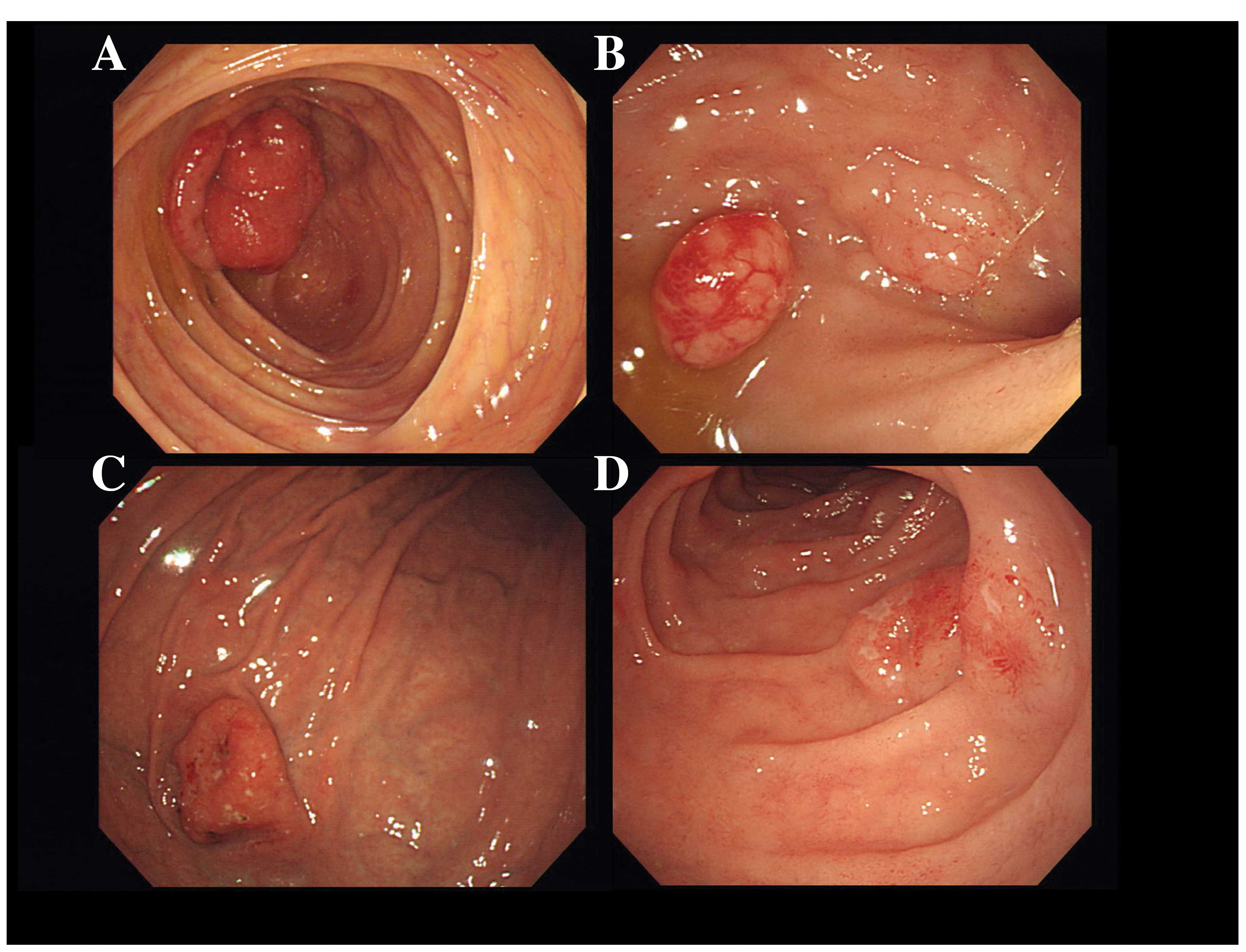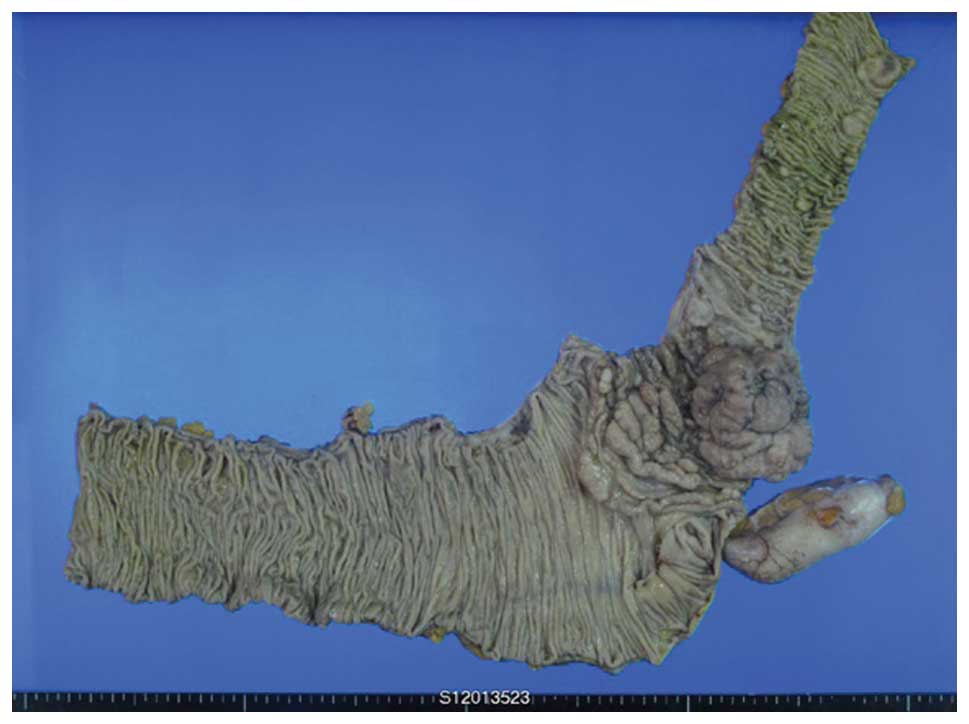Mantle cell lymphoma with multiple lymphomatous polyposis and intussusception: A case report
- Authors:
- Published online on: November 23, 2015 https://doi.org/10.3892/ol.2015.3954
- Pages: 654-656
Abstract
Introduction
Mantle cell lymphoma (MCL) is a non-Hodgkin's lymphoma composed of small lymphoid cells. MCL usually occurs in males with a median age of 60 years; however, its frequency accounts for ~4% of all lymphomas in the Western countries (1). It commonly involves the gastrointestinal (GI) tract and may present as multiple lymphomatous polyposis (MLP), which frequently occurs in the colon and small bowel (2). However, numerous sessile or polypoid lesions may be identified throughout the GI tract (3).
Malignant lymphoma is an uncommon cause of intussusception, which is estimated to cause <1% of all intussusception cases (4). MLP combined with intussusception is rare in MCL patients. Only a limited number of MCL cases with intussusception have been previously reported (5–7). The current study presented a case of GI tract MCL with MLP and ileocecal intussusception that was effectively treated with surgery and chemotherapy.
Case report
A 54-year-old male was referred to the Division of Gastroenterology and Hepatology (Korea University College of Medicine, Seoul, Korea) with abnormal computed tomography (CT) findings in the right lower abdomen (June 2012). The patient had been diagnosed with stage I bladder cancer 2 years earlier, and had undergone transurethral resection of the bladder tumor and intracavitary instillation of mitomycin. No evidence of bladder cancer recurrence was observed during the 2 years of follow-up. Upon referral to the Division of Gastroenterology and Hepatology, intussusception and a mass in the terminal ileum were identified by performing contrast-enhanced abdominal CT scans (Fig. 1). Physical examination revealed normal vital signs and a soft distended abdomen with normoactive bowel sounds. The initial laboratory findings were as follows: hemoglobin level, 14.2 g/dl (normal range: 12.0–17.0 g/dl); white blood cell count, 8,000/µl (normal range: 4,500–11,000/µl); platelet count, 171,000/µl (normal range: 150,000–400,000/µl); and C-reactive protein level, 0.6 mg/dl (normal range: 0–5.0 mg/dl). Blood biochemical analyses revealed no pathological findings, while the β2-microglobulin and lactate dehydrogenase (LDH) levels were normal. Written informed consent was obtained from the patient.
A total colonoscopy (CF-H260AL; Olympus Optical, Tokyo, Japan) revealed ileocolic intussusception and a large mass in the distal ileum (Fig. 2A). The mass had a smooth rubber-like surface, fungating shape with multilobular contour and a diameter of ~4–8 mm. Multiple round nodules were also identified in the distal ileum (Fig. 2B) and rectum. Esophagogastroduodenoscopy (GIF-H260; Olympus Optical) revealed a polypoid tumor that measured ~30 mm in the high body of the stomach (Fig. 2C) and multiple small subepithelial nodular lesions from the bulb to the second portion of the duodenum (Fig. 2D). Multiple biopsies of the complete GI tract presented diffuse infiltration of monotonous small-to-medium sized, lymphoid cells. In addition, immunohistochemical analysis of the biopsy tissues demonstrated positive staining for CD20, CD5, Bcl-2, CD43 and cyclin D1 (Fig. 3); therefore, the diagnosis was confirmed to be MCL. A positron emission tomography (PET) scan indicated intense hyper-metabolism of all digestive structures, extending from the stomach to the rectal wall. Furthermore, a bone marrow biopsy and chromosomal study were also performed; however, no abnormal results were observed. The MCL International Prognostic Index score (8) was 8.1, and the disease was classified as stage IV according to the Ann Arbor staging system (9).
The patient underwent right hemicolectomy with distal ileum resection and ileocolic anastomosis (Fig. 4). After 20 days, chemotherapy with rituximab plus hyper-CVAD (R-hyper-CVAD) was administered, with alternating course A and B regimens for cycles during 6 months [course A: Rituximab (375 mg/m2, intravenous, IV, day 1), cyclophosphamide (300 mg/m2, IV, day 2–4), vincristine (1.4 mg/m2, IV, day 5 and 12), doxorubicin (1.6 mg/m2, IV, day 5–7) and dexamethasone; course B: Rituximab (375 mg/m2, IV, day 1), methotrexate (1,000 mg/m2, IV, day 2), leucovorin (15 mg every 6 h, IV, 10 times, day 3–5) and cytarabine (3 g/m2, every 6 h, IV, day 3 and 4)]. Following 6 planned cycles of R-hyper-CVAD, upper and lower endoscopic examinations demonstrated complete remission and absence of polypoid lesions in the GI tract. The remission lasted over 18 months and a follow-up PET scan revealed no abnormal hypermetabolic lesions. There was no evidence of recurrence in abdominal CT and endoscopic examination until the present time.
Discussion
MCL is a mature B-cell non-Hodgkin's lymphoma that, according to previous epidemiological data, comprises up to 4% of all lymphoma cases (1). Although various studies have demonstrated improvement of the median survival using aggressive chemotherapeutic strategies, the prognosis of MCL remains unfavorable (10–13). MCL generally occurs in adults with a median age of 60 years and has a male predominance (14). Overexpression of cyclin D1 is a typical characteristic of MCL.
MLP was initially defined by Cornes in 1961 (15). It involves numerous polypoid lesions throughout the GI tract, caused by malignant lymphoma. Diffuse and nodular polypoid lesions are a characteristic feature at presentation; therefore, involvement of the GI tract must be investigated by endoscopic examination in lymphoma patients. Common clinical symptoms include abdominal pain, diarrhea and weight loss, while protein-losing enteropathy, chylous ascites, intestinal malabsorption and perforation are less frequently observed (16). In rare cases, MCL with MLP results in intestinal obstruction or intussusception. Several previous studies have analyzed the clinical features and outcome of MLP (16); however, no standardized therapeutic options exist for GI cases of MCP with MLP.
Only a limited number of MCL cases presenting with intussusception have been reported (5–7). In the majority of cases, patients were treated with the R-CHOP chemotherapy regimen (cyclophosphamide, doxorubicin, vincristine and prednisone, in combination with rituximab) and surgical resection. However, it has been suggested that the R-Hyper-CVAD regimen (cyclophosphamide, vincristine, doxorubicin, dexamethasone, cytarabine and methotrexate, in combination with rituximab) is associated with improved response rates in MCL (17). The main concern in the present case was the risk of remission failure or severe complications, such as intestinal obstruction due to unresolved intussusception. Therefore, prior to chemotherapy, the patient underwent right hemicolectomy for tumor debulking and prevention of complications. Subsequently, R-hyper-CVAD chemotherapy was administered.
In asymptomatic patients, it remains unclear whether surgery prior chemotherapy is required and whether 6 cycles of chemotherapy are appropriate to treat MCL with intussusception. However, the therapeutic strategy in the present study demonstrated marked results and good response. Progress in the current patient suggested that complete remission may be achieved in MCL with MLP following the administration of R-hyper-CVAD. In conclusion, operative bowel resection may be a feasible option in MCL, when MLP is associated with asymptomatic intussusception.
Acknowledgements
This study was supported by the Technology Innovation Program (or Industrial Strategic technology development program; grant no. 10049743), for establishing a medical device development open platform, as a hub for accelerating close firm-hospital communication) funded by the Ministry of Trade, Industry and Energy (South Korea).
References
|
Schmidt C and Dreyling M: Therapy of mantle cell lymphoma: Current standards and future strategies. Hematol Oncol Clin North Am. 22:953–963. 2008. View Article : Google Scholar : PubMed/NCBI | |
|
Kim JH, Jung HW, Kang KJ, et al: Endoscopic findings in mantle cell lymphoma with gastrointestinal tract involvement. Acta Haematol. 127:129–134. 2012. View Article : Google Scholar : PubMed/NCBI | |
|
Chung K, Tomowiak C, Yacoub M, et al: A rare case of mantle cell lymphoma as lymphomatous polyposis with widespread involvement of the digestive tract. Clin Res Hepatol Gastroenterol. 35:74–78. 2011. View Article : Google Scholar : PubMed/NCBI | |
|
Chiang JM and Lin YS: Tumor spectrum of adult intussusception. J Surg Oncol. 98:444–447. 2008. View Article : Google Scholar : PubMed/NCBI | |
|
Kella VK, Constantine R, Parikh NS, et al: Mantle cell lymphoma of the gastrointestinal tract presenting with multiple intussusceptions-case report and review of literature. World J Surg Oncol. 7:602009. View Article : Google Scholar : PubMed/NCBI | |
|
Grin A, Chetty R and Bailey D: Mantle cell lymphoma as a rare cause of intussusception: A report of 2 cases. Ann Diagn Pathol. 13:398–401. 2009. View Article : Google Scholar : PubMed/NCBI | |
|
Sucker C, Klima KM, Doelken G, et al: Unusual sites of involvement in non-Hodgkin's lymphoma: Case 3. Intussusception as a rare complication of mantle-cell lymphoma. J Clin Oncol. 20:4397–4398. 2002.PubMed/NCBI | |
|
Carbone PP, Kaplan HS, Musshoff K, et al: Report of the Committee on Hodgkin's disease staging classification. Cancer Res. 31:1860–1861. 1971.PubMed/NCBI | |
|
Hoster E, Dreyling M, Klapper W, et al: German Low Grade Lymphoma Study Group (GLSG); European Mantle Cell Lymphoma Network: A new prognostic index (MIPI) for patients with advanced stage mantle cell lymphoma. Blood. 111:558–5652008. View Article : Google Scholar | |
|
Herrmann A, Hoster E, Zwingers T, et al: Improvement of overall survival in advanced stage mantle cell lymphoma. J Clin Oncol. 27:511–518. 2009. View Article : Google Scholar : PubMed/NCBI | |
|
Kluin-Nelemans HC, Hoster E, Hermine O, et al: Treatment of older patients with mantle-cell lymphoma. N Engl J Med. 367:520–531. 2012. View Article : Google Scholar : PubMed/NCBI | |
|
Rummel MJ, Niederle N, Maschmeyer G, et al: Study group indolent Lymphomas (StiL): Bendamustine plus rituximab versus CHOP plus rituximab as first-line treatment for patients with indolent and mantle-cell lymphomas: An open-label, multicentre, randomized, phase 3 non-inferiority trial. Lancet. 381:1203–1210. 2013. View Article : Google Scholar : PubMed/NCBI | |
|
Visco C, Finotto S, Zambello R, et al: Combination of rituximab, bendamustine, and cytarabine for patients with mantle-cell non-Hodgkin lymphoma ineligible for intensive regimens or autologous transplantation. J Clin Oncol. 31:1442–1449. 2013. View Article : Google Scholar : PubMed/NCBI | |
|
The Non-Hodgkin's Lymphoma Classification Project: A clinical evaluation of the International Lymphoma Study Group classification of non-Hodgkin's lymphoma. Blood. 89:3909–3918. 1997.PubMed/NCBI | |
|
Cornes JS: Multiple lymphomatous polyposis of the gastrointestinal tract. Cancer. 14:249–257. 1961. View Article : Google Scholar : PubMed/NCBI | |
|
Ruskoné-Fourmestraux A, Delmer A, Lavergne A, et al: Multiple lymphomatous polyposis of the gastrointestinal tract: Prospective clinicopathologic study of 31 cases. Groupe D'etude des Lymphomes Digestifs. Gastroenterology. 112:7–16. 1997. View Article : Google Scholar : PubMed/NCBI | |
|
Vose JM: Mantle cell lymphoma: 2012 update on diagnosis, risk-stratification and clinical management. Am J Hematol. 87:604–609. 2012. View Article : Google Scholar : PubMed/NCBI |













